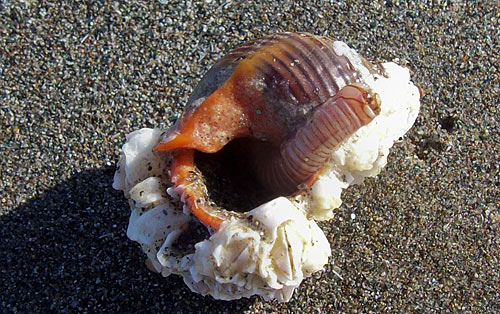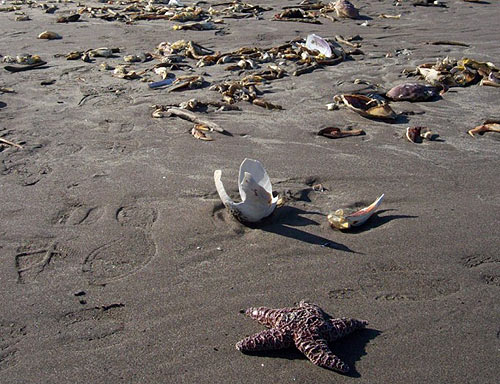 |
Oregon's Pacific Ocean Area Enters Beachcombing Season with Plenty of Oddities
Published 10/29/2012

(Seaside, Oregon) – Beachcombing season seems to have arrived on the Oregon coast, and part of the proof of this is a wide range of fun and funky things found by Seaside Aquarium's Tiffany Boothe. (Photos by Tiffany Boothe)
“It has been very exciting lately walking along the Seaside beach,” Boothe said last week. “We found this large deposit of marine debris at the mouth of the river north of 12th Ave, a soup fin shark at the cove, a black skate egg casing, and jellies.”
Among her other finds were an impressive little sea shell.

The skate egg casing sometimes resembles seaweed, but it is a very tough, protective casing which can contain anywhere from two to seven embryos per casing.
“Adult female skates will drop these on the ocean floor, where the casing will drift for nine to twelve months,” Boothe said. “During that time, the embryos feed upon a yolk sack that they are attached to. When the babies are developed enough to be self-sufficient, one end of the casing will open up and the baby skates - now 3.5 inches long – will emerge.”

Soupfin sharks are known by various names, including flake, tope, school and vitamin shark (which comes from the fact their livers are extremely rich in vitamin A). Along the Oregon coast and the coastlines of Washington and Canada, they are mostly males running these waters. But off California waters they are equally male and female.
You can identify a soupfin shark easily by its sleek, think body and pointy nose, along with a second dorsal fin and a large structure on their tail.
They are found in groups of around 50 and have been known to travel hundreds of miles to breed.

Sea gooseberries are also known as comb jellies and appear on the beach as fascinating little creatures which look like bubbles.
“But once in salt water this beautiful and graceful jelly begins to move, pulsating the small cilia that line the outside of the jelly,” Boothe said.
The sea gooseberry has two tentacles, which are about three times longer than the body of the critter. These are lined with colloblasts – a specialized adhesive cell that helps snag food for the comb jelly.
They only live about four to six months.
“The body of a Sea Gooseberry is virtually transparent and the many cilia refract the light, producing rainbow-like colors that can give the false appearance of bioluminescence,” Boothe said.
The run of storms this week should result in plenty of interesting objects to find on the beaches.

Any of the beaches along the Oregon coast will be good for discoveries and oddity hunting, including Cannon Beach, Manzanita, Rockaway Beach, Warrenton, Oceanside, Pacific City, Lincoln City, Gleneden Beach, Newport, Waldport and Yachats.
Always keep beach safety in mind, however.
More About Oregon Coast hotels, lodging.....
More About Oregon Coast Restaurants, Dining.....
 |
 |
LATEST Oregon Coast Whale Articles
Oregon Coast Whales - Guide to Whale Watching; Whale News, Blog |
|
Twitter / OregonCoastBuzz Twitter updates from Oregon Coast / OregonCoastBuzz. OregonCoastBuzz: #Geology of an #OregonCoast Icon: Sweeping Cape Kiwanda http... 11 Jun 2013 at 1:10pm OregonCoastBuzz: #Geology of an #OregonCoast Icon: Sweeping Cape Kiwanda http://t.co/OXcr6ki9Tf #northwest #Oregon #pdx #Portland #or #traveltips #science OregonCoastBuzz: Oregon Coast Fourth of July Preview, Independence Day - comp... 11 Jun 2013 at 11:25am OregonCoastBuzz: Oregon Coast Fourth of July Preview, Independence Day - complete guide http://t.co/WSy8ioYtd4 #Oregon #northwest #pdx #Portland #Eugene #or OregonCoastBuzz: Intricate #OregonCoast Oddities: Surreal Slabs of Ona Beach ... 11 Jun 2013 at 10:11am OregonCoastBuzz: Intricate #OregonCoast Oddities: Surreal Slabs of Ona Beach http://t.co/9cI0oJ5WAX #Oregon #beaches #northwest #Eugene #Corvallis #pdx #or OregonCoastBuzz: Complete Independence Day, 4th July Preview #OregonCoast htt... 10 Jun 2013 at 11:43pm OregonCoastBuzz: Complete Independence Day, 4th July Preview #OregonCoast http://t.co/WSy8ioYtd4 #oregon #northwest #pdx #portland #eugene #corvallis #or OregonCoastBuzz: Today's #OregonCoast: Depoe chaos, Astoria glow, Cannon Beac... 10 Jun 2013 at 5:01pm OregonCoastBuzz: Today's #OregonCoast: Depoe chaos, Astoria glow, Cannon Beach Xmas, Yachats explodes http://t.co/5lDrLIKDas #oregon #beaches #norhtwest #or |
Back to Oregon Coast
Contact Advertise on BeachConnection.net
All Content, unless otherwise attributed, copyright BeachConnection.net Unauthorized use or publication is not permitted
Secrets of the Season |
Unusual Travel Articles TravelParanormal.com allows you to submit your own creepy tale or debunk one - or see up-to-the-minute news headlines about travel and the paranormal. News Headlines from All Over Oregon Need to scan Oregon headlines? Constantly updated news from all over Oregon: a comprehensive, up-to-the-minute display of news headlines from a variety of media |






































